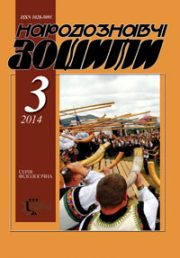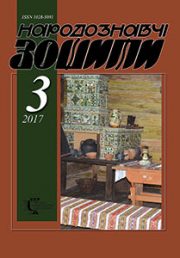The Ethnology Notebooks. 2017, 4 (136), 828–834
UDK 94:314](=1:43812:477.86/.87).”175/195″
DOI https://doi.org/10.15407/nz2017.04.828
ANALYSIS OF SETTLINGS OF CISNA COMMUNE SINCE 2nd half of 18th to 2nd half of 20th century USING GIS
Kozak Ihor Ivanovych — doctor of biological sciences
professor of department of landscape ecology Lublin
catholic university of the name of John Pavlo ІІ.
Aleje Racіawickie 14, 20-950 Lublin
Kozak Hanna Hryhorivna — master’s degree, assistant of department
guard of environment and landscape
Lublin catholic university of the name of John Pavlo ІІ.
Aleje Racіawickie 14, 20-950 Lublin
Abstract. The study was conducted within the actual area of Cisna commune in Lesko district, Podkarpackie voivodeship in Eastern Poland. The dynamics of settlements in Cisna commune from the 2nd half of the 18th century to 2nd half of 20th century was discussed. Maps and historical data were analyzed in the Arc- GIS 10.3 program. We analyzed the Cisna commune in terms of the changes of settlements and used maps for the analysis of changes in its structure. The first of these was the historical map, namely the tactical map of «WIG». Next we analyzed maps from the «WMS» server. The changes in the number of villages and households were presented. Population dynamics for Greek-catholics, «Latynnykys» and Jews for the year 1785 and Ukrainians in comparison with the number of Poles and Jews for the year 1939 were shown.
Keywords: dynamics, village, GIS, Cisna commune.
Received 6.07.2017
REFERENCES
Pavliuk, S. (1986). Narodna ahrotekhnika ukraintsiv Karpat druhoi polovyny XIX – pochatku XX st. Kyiv: Naukova dumka [in Ukrainian].
Teslia, I. (1980). Heohrafichnyj narys Bojkivschyny. Bojkivschyna: Monohrafichnyj Zbirnyk pro Bojkivschynu z Heohrafii, Istorii, Etnohrafii i Pobutu. Redaktor i holova redkolehii Myron Utrysko. Filadel’fiia; N’iu-Jork. S. 23–80. (Ukrains’kyj Arkhiv. T. XXXIV) [in Ukrainian].
Utrysko, M. (1984). Etnohrafichni doslidzhennia Bojkivschyny mizh dvoma vijnamy. LB (E).. Ch. 2/40 (51). S. 1–15 [in Ukrainian].
Affek, A. (2011). Wartości kraj obrazu opuszczonego przez ludność na przykładzie byłej Rusińskiej wsi Borysławka.Prace Komisji Kraj obrazu Kulturowego. № 15. S. 148–160 [in Polish].
Agnoletti, M.(2006). The Conservation of Cultural Landscapes. CAB International. New York.
Ambrozy, S.(1998). Kierunki sukcesji zbiorowisk roślinnych z olsząszarą Alnusincana (L). Moench na gruntach porolnych w Bieszczadach Zachodnich. S. Ambrozy& S. Wika. Prace in Stytutu badawczego leśnictwa. Seria A. № 855. S. 104–142 [in Polish].
Antrop, M. (2005). Why lands capes of the past are important for the future. Landscape Urban Plann. № 70. S. 21–34.
Augustyn, B.(2016). Pozostałości dawnej zabudowywsi. Bojkowszczyzna Zachodnia – wczoraj, dziśijutro.Warszawa. Т. 2. S. 65–85 [in Polish].
Bieszczady. Słownik historycznokrajobrazowy. Część 2. Gmina Cisna. (1996). Ustrzyki Dolne: Wydawnictwo Stanisław Kryciński [in Polish].
Blażejowsky, D.(1995). Historical Šematism of the Eparchy of Peremyśl’. Lviv: Kameniar.
Budzyński, Z.(1993). Ludnośc pogranicza Polsko-Ruskiego w drugiej Polowie 18 wieku. Przemyśl; Rzeszów [in Polish].
Еlbakidze, M. (2007). Implementing sustainable forest management in Ukraine’s Carpathian mountains: the role of traditional village systems. M. Еlbakidze & P. Angelstam. Forest Ecology and Management. № 249/1. S. 28–38.
European Landscape Convention (2000).. European Treaty; Council of Europe. № 176.
Gil, A.(2004). Deportacja Ukraińców z Polski w latach 1944–1946 jakoproblem w aktualnych stosunkach Polsko-Ukraińskich. Lublin: Wydawnictwo Instytutu Europy Środkowo-Wschodniej [in Polish].
Holly, G.(2014). Stosunki wyznaniowe i narodow ościowena pograniczu polsko-słowacko-ukraińskim.Roczniki Bieszczadzkie. № 15. S. 179–207 [in Polish].
Iwanusiw, O. (1986). Churchin Ruins: Thedem ise of Ukrainian churchesin the eparchy of Peremyshl.
Kryciński S.(1995).. Cerkwie w Bieszczadach. Rewasz [in Polish].
Kubijovyč, V.(1983).. Ethnicgroups of the South-Western Ukraine (Galyčyna-Galicia). 1.1.1939.München: Logos.
Luboński, P. (2015).. Przewodnik Bieszczady.Boсz [in Polish].
Stępień, A. (2011). Trój wymiarowa rekonstrukcja obiektu architektoniczno-krajobrazowe gonaprzykładzienieistniejącej cerkwi w Bieniowej (Bieszczady Zachodnie).. A. Stępien, I. Kozak&H. Kozak. Roczniki Bieszczadzkie. № 19. S. 379–387 [in Polish].
UNESCO, Evaluations of cultural properties. International Councilon Monumentsand Sites (ICOMOS). (1999). UNESCO; WHC99/CONF.209/INF.7. Marrakesh; Morocco.
Urbański, J. (2010). GIS w badania chprzyrodniczych. Gdańsk: Wydawnictwo Uniwersytetu Gdańskiego [in Polish].
Wolski, J.(2007). Transformations of the high Bieszczady Mountains rurall and scape during the last 150 years.Warszawa: IGiPZ PAN im. S. Leszczyckiego.
GUS. Stanistruktura ludności. 2011. Baza Demograficzna. Retrieved from://demografia.stat.gov.pl/BazaDemografia/ [in Polish].
Skorowidz Map. 1:100 000. Retrieved from: http://igrek.amzp.pl/mapindex.php?cat=WIG100 [in Polish].






